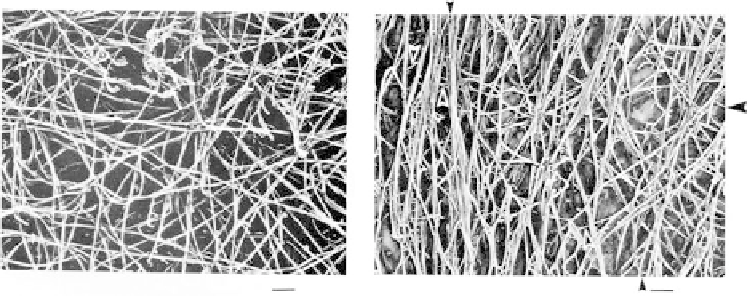Biomedical Engineering Reference
In-Depth Information
0.5
m
0.5
m
µ
µ
Figure 9.18
Micrographs of cellulose ribbons obtained in standard growth
conditions-control BC (left) and obtained in presence of Xyloglucans-BC/xyloglucans
nanocomposites (right). (Whitney, S.E.C.; Brigham, J.E.; Darke, A.H.; Reid, J.S.G.; Gid-
ley,M.J., In-vitroassemblyof cellulose/xyloglucannetworks-ultrastructural andmolecular
aspects.Plant Journal,1995,8(4),491-504.Copyright1995,Reprintedwithpermissionfrom
Wiley-Blackwell.)
system only exhibited the mobile xyloglucan cross-bridges, clearly illustrating the poten-
tial of biomimetic approaches to develop nanocomposites with unique morphologies (65).
When the small deformation rheological properties of the intact and pulverized
BC/xyloglucan nanocomposites were compared to those of tomatoes' primary cell
wall and of BC alone, striking similarities were observed (66). Namely, the dynamic
viscosity, storage (G') and loss (G”) shear moduli followed similar trends in the tomato
cell wall, pulverized bacterial cellulose and in BC/xyloglucan nanocomposites (66) with
a noteworthy solid-like behavior. Hence it was proposed that under small deformation
the entangled cellulosic rods rather than the xyloglucan crosslinks dominated the
shear moduli of these nanocomposites. Cellulose was therefore the key mechanical
component that contributed to the linear viscoelastic behavior of BC/xyloglucan
nanocomposites. In contrast xyloglucans appeared to play a significant role in the
nonlinear uniaxial tensile properties of BC/xyloglucan nanocomposites (66). When
tested under hydrated conditions, BC sheets were stiffer, stronger but less extensible
than BC/xyloglucan sheets (all with less than 10% cellulose content) (Figure 9.20). This
mechanical response was rationalized in terms of the different entanglements in BC
and in the BC/xyloglucan nanocomposite (66) and in a later publication modeled based
on small-angle X-ray scattering experiments performed during uniaxial loading tests
(58). Namely, it was proposed that in the randomly oriented fibers of neat BC, looped
links required more force and allowed low stretching before failure (Figure 9.19).
Alternatively, alignment of cellulose ribbons in the BC/xyloglucans nanocomposites
generated entanglements between somewhat parallel fibrils. Upon uniaxial loading the
ribbons or crosslinked domains could orient with the loading direction until the breaking
point at a large extension (Figure 9.19). These concepts would explain the lower
tensile strength and stiffness and higher extensibility of BC/xyloglucan nanocomposites
compared to neat BC in uniaxial tensile loading.

Search WWH ::

Custom Search